BUS101: Business Environment Report - Tesco Stakeholder Analysis
VerifiedAdded on 2023/01/19
|12
|3570
|39
Report
AI Summary
This report provides a comprehensive analysis of Tesco's business environment, focusing on its operations as a multinational grocery and general merchandise retailer. It begins by exploring the different types of businesses, including public, volunteer, and private organizations, and their respective goals. The report then delves into how Tesco addresses the objectives of various stakeholders, such as employees, shareholders, customers, and the government, highlighting the importance of internal and external stakeholder management. A significant portion of the report is dedicated to the PESTLE analysis, examining the political, economic, social, technological, legal, and environmental factors influencing Tesco's business activities. The analysis covers both the positive and negative impacts of these factors, providing a detailed understanding of the challenges and opportunities Tesco faces in its operational environment. The report concludes by summarizing the key findings and insights into Tesco's strategies for navigating its business environment and achieving its objectives.
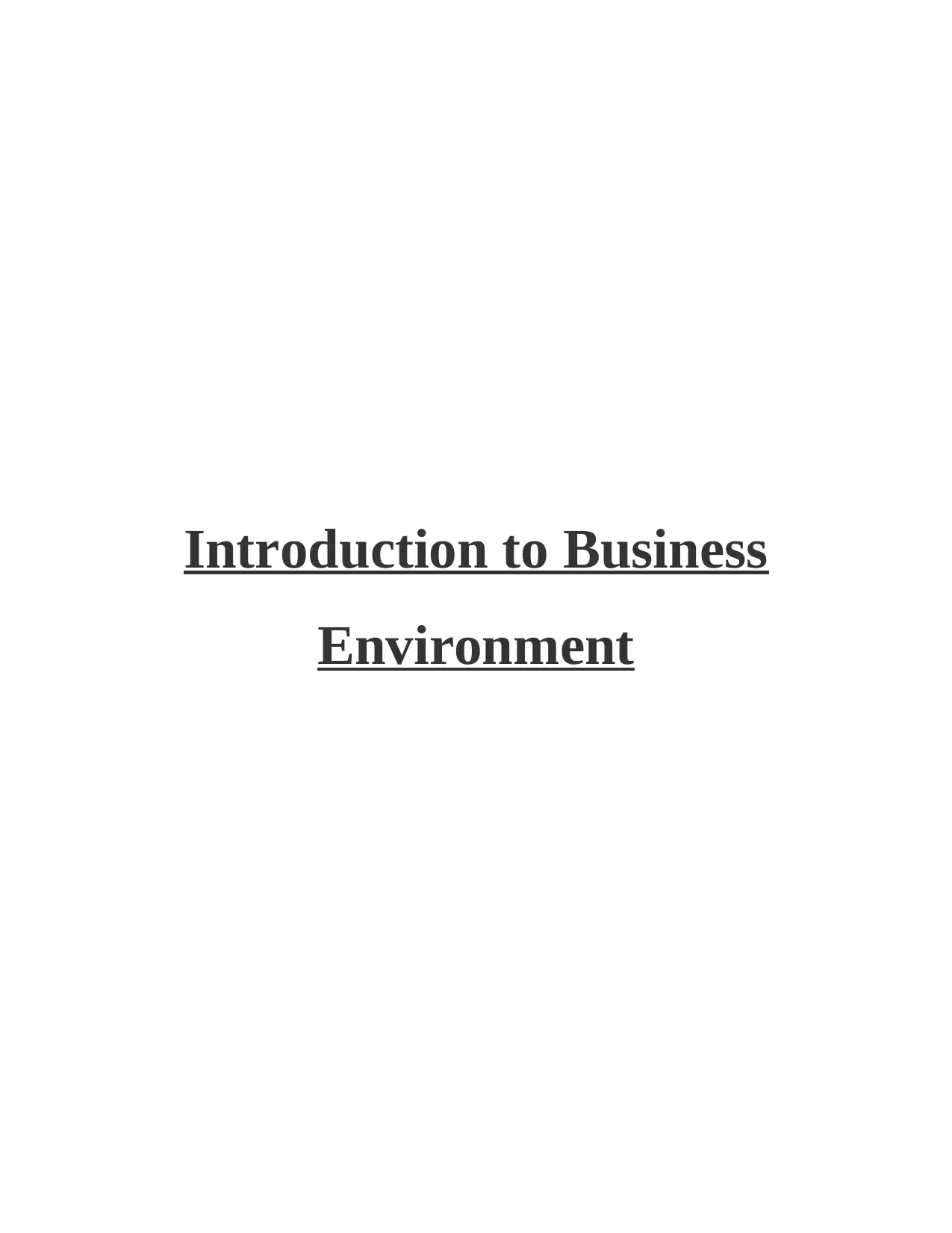
Introduction to Business
Environment
Environment
Paraphrase This Document
Need a fresh take? Get an instant paraphrase of this document with our AI Paraphraser

Table of Contents
INTRODUCTION...........................................................................................................................1
LO1..................................................................................................................................................1
A) Variation between individual types of business and their goals.......................................1
LO2..................................................................................................................................................3
B) Organization meets the objectives of different stakeholders......................................................3
LO3..................................................................................................................................................5
C) Pestle analysis method ......................................................................................................5
CONCLUSION................................................................................................................................8
REFERENCES................................................................................................................................9
INTRODUCTION...........................................................................................................................1
LO1..................................................................................................................................................1
A) Variation between individual types of business and their goals.......................................1
LO2..................................................................................................................................................3
B) Organization meets the objectives of different stakeholders......................................................3
LO3..................................................................................................................................................5
C) Pestle analysis method ......................................................................................................5
CONCLUSION................................................................................................................................8
REFERENCES................................................................................................................................9
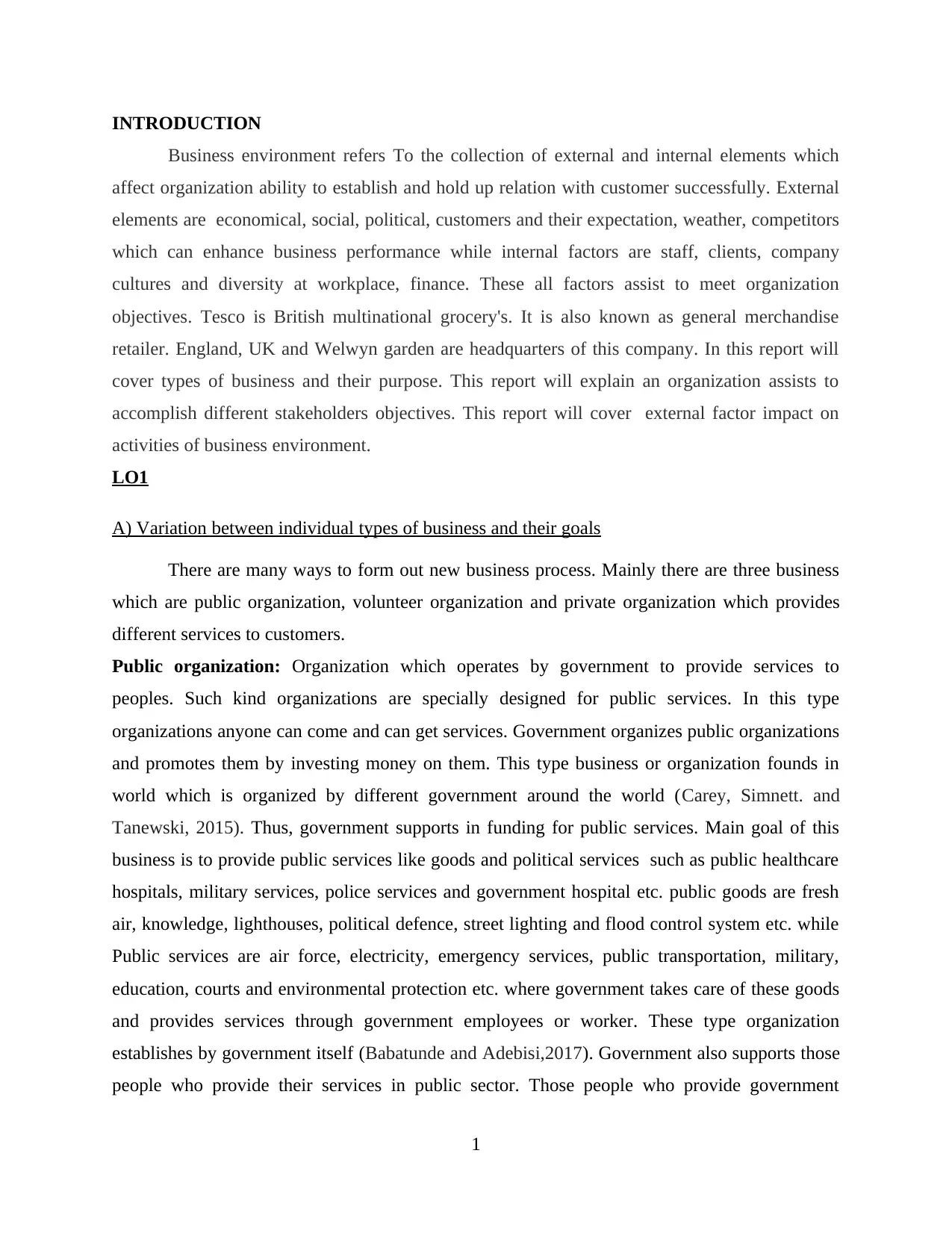
INTRODUCTION
Business environment refers To the collection of external and internal elements which
affect organization ability to establish and hold up relation with customer successfully. External
elements are economical, social, political, customers and their expectation, weather, competitors
which can enhance business performance while internal factors are staff, clients, company
cultures and diversity at workplace, finance. These all factors assist to meet organization
objectives. Tesco is British multinational grocery's. It is also known as general merchandise
retailer. England, UK and Welwyn garden are headquarters of this company. In this report will
cover types of business and their purpose. This report will explain an organization assists to
accomplish different stakeholders objectives. This report will cover external factor impact on
activities of business environment.
LO1
A) Variation between individual types of business and their goals
There are many ways to form out new business process. Mainly there are three business
which are public organization, volunteer organization and private organization which provides
different services to customers.
Public organization: Organization which operates by government to provide services to
peoples. Such kind organizations are specially designed for public services. In this type
organizations anyone can come and can get services. Government organizes public organizations
and promotes them by investing money on them. This type business or organization founds in
world which is organized by different government around the world (Carey, Simnett. and
Tanewski, 2015). Thus, government supports in funding for public services. Main goal of this
business is to provide public services like goods and political services such as public healthcare
hospitals, military services, police services and government hospital etc. public goods are fresh
air, knowledge, lighthouses, political defence, street lighting and flood control system etc. while
Public services are air force, electricity, emergency services, public transportation, military,
education, courts and environmental protection etc. where government takes care of these goods
and provides services through government employees or worker. These type organization
establishes by government itself (Babatunde and Adebisi,2017). Government also supports those
people who provide their services in public sector. Those people who provide government
1
Business environment refers To the collection of external and internal elements which
affect organization ability to establish and hold up relation with customer successfully. External
elements are economical, social, political, customers and their expectation, weather, competitors
which can enhance business performance while internal factors are staff, clients, company
cultures and diversity at workplace, finance. These all factors assist to meet organization
objectives. Tesco is British multinational grocery's. It is also known as general merchandise
retailer. England, UK and Welwyn garden are headquarters of this company. In this report will
cover types of business and their purpose. This report will explain an organization assists to
accomplish different stakeholders objectives. This report will cover external factor impact on
activities of business environment.
LO1
A) Variation between individual types of business and their goals
There are many ways to form out new business process. Mainly there are three business
which are public organization, volunteer organization and private organization which provides
different services to customers.
Public organization: Organization which operates by government to provide services to
peoples. Such kind organizations are specially designed for public services. In this type
organizations anyone can come and can get services. Government organizes public organizations
and promotes them by investing money on them. This type business or organization founds in
world which is organized by different government around the world (Carey, Simnett. and
Tanewski, 2015). Thus, government supports in funding for public services. Main goal of this
business is to provide public services like goods and political services such as public healthcare
hospitals, military services, police services and government hospital etc. public goods are fresh
air, knowledge, lighthouses, political defence, street lighting and flood control system etc. while
Public services are air force, electricity, emergency services, public transportation, military,
education, courts and environmental protection etc. where government takes care of these goods
and provides services through government employees or worker. These type organization
establishes by government itself (Babatunde and Adebisi,2017). Government also supports those
people who provide their services in public sector. Those people who provide government
1
⊘ This is a preview!⊘
Do you want full access?
Subscribe today to unlock all pages.

Trusted by 1+ million students worldwide
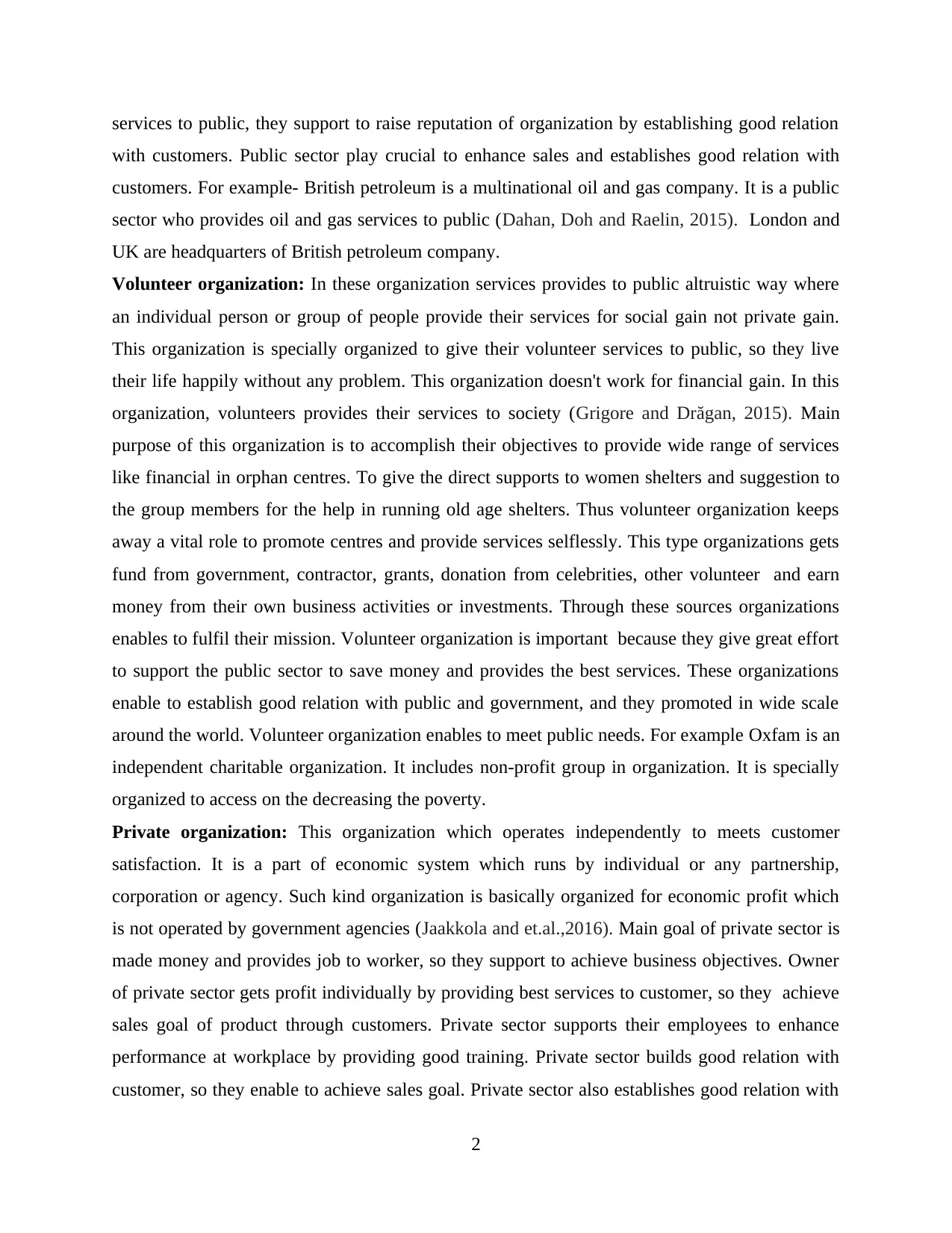
services to public, they support to raise reputation of organization by establishing good relation
with customers. Public sector play crucial to enhance sales and establishes good relation with
customers. For example- British petroleum is a multinational oil and gas company. It is a public
sector who provides oil and gas services to public (Dahan, Doh and Raelin, 2015). London and
UK are headquarters of British petroleum company.
Volunteer organization: In these organization services provides to public altruistic way where
an individual person or group of people provide their services for social gain not private gain.
This organization is specially organized to give their volunteer services to public, so they live
their life happily without any problem. This organization doesn't work for financial gain. In this
organization, volunteers provides their services to society (Grigore and Drăgan, 2015). Main
purpose of this organization is to accomplish their objectives to provide wide range of services
like financial in orphan centres. To give the direct supports to women shelters and suggestion to
the group members for the help in running old age shelters. Thus volunteer organization keeps
away a vital role to promote centres and provide services selflessly. This type organizations gets
fund from government, contractor, grants, donation from celebrities, other volunteer and earn
money from their own business activities or investments. Through these sources organizations
enables to fulfil their mission. Volunteer organization is important because they give great effort
to support the public sector to save money and provides the best services. These organizations
enable to establish good relation with public and government, and they promoted in wide scale
around the world. Volunteer organization enables to meet public needs. For example Oxfam is an
independent charitable organization. It includes non-profit group in organization. It is specially
organized to access on the decreasing the poverty.
Private organization: This organization which operates independently to meets customer
satisfaction. It is a part of economic system which runs by individual or any partnership,
corporation or agency. Such kind organization is basically organized for economic profit which
is not operated by government agencies (Jaakkola and et.al.,2016). Main goal of private sector is
made money and provides job to worker, so they support to achieve business objectives. Owner
of private sector gets profit individually by providing best services to customer, so they achieve
sales goal of product through customers. Private sector supports their employees to enhance
performance at workplace by providing good training. Private sector builds good relation with
customer, so they enable to achieve sales goal. Private sector also establishes good relation with
2
with customers. Public sector play crucial to enhance sales and establishes good relation with
customers. For example- British petroleum is a multinational oil and gas company. It is a public
sector who provides oil and gas services to public (Dahan, Doh and Raelin, 2015). London and
UK are headquarters of British petroleum company.
Volunteer organization: In these organization services provides to public altruistic way where
an individual person or group of people provide their services for social gain not private gain.
This organization is specially organized to give their volunteer services to public, so they live
their life happily without any problem. This organization doesn't work for financial gain. In this
organization, volunteers provides their services to society (Grigore and Drăgan, 2015). Main
purpose of this organization is to accomplish their objectives to provide wide range of services
like financial in orphan centres. To give the direct supports to women shelters and suggestion to
the group members for the help in running old age shelters. Thus volunteer organization keeps
away a vital role to promote centres and provide services selflessly. This type organizations gets
fund from government, contractor, grants, donation from celebrities, other volunteer and earn
money from their own business activities or investments. Through these sources organizations
enables to fulfil their mission. Volunteer organization is important because they give great effort
to support the public sector to save money and provides the best services. These organizations
enable to establish good relation with public and government, and they promoted in wide scale
around the world. Volunteer organization enables to meet public needs. For example Oxfam is an
independent charitable organization. It includes non-profit group in organization. It is specially
organized to access on the decreasing the poverty.
Private organization: This organization which operates independently to meets customer
satisfaction. It is a part of economic system which runs by individual or any partnership,
corporation or agency. Such kind organization is basically organized for economic profit which
is not operated by government agencies (Jaakkola and et.al.,2016). Main goal of private sector is
made money and provides job to worker, so they support to achieve business objectives. Owner
of private sector gets profit individually by providing best services to customer, so they achieve
sales goal of product through customers. Private sector supports their employees to enhance
performance at workplace by providing good training. Private sector builds good relation with
customer, so they enable to achieve sales goal. Private sector also establishes good relation with
2
Paraphrase This Document
Need a fresh take? Get an instant paraphrase of this document with our AI Paraphraser

their employees to accomplish basic needs of employees, so-that they provide excellent
performance at workplace to customer. Through employee's satisfaction organization achieves
private gain. For example Tesco, It is a multinational groceries and general merchandise retailer.
It is a private sector which work for gain economical profit and meets customers satisfaction.
This company focuses on their product services and product quality so customer attr5acts and
retain for long time. This company also focuses on their employees (Jansen, 2017).
Organization. Provides friendly atmosphere at workplace so employees enables to give the best
performance at workplace. To gain profit in company, company always offers different variety's
in product, so that selling ratio enhance and alleviate economical scale in company.
LO2
B) Organization meets the objectives of different stakeholders
Stakeholder refers a person, employees stake, customers stake, investors stake, suppliers
and vendors stake, community and government stake erc.. Who affects organization and affects
by organization. Each of these group stake-holders contains different objective for business.
Organization meets stakeholders objectives to accomplishing their demands. Stakeholders are
two types internal and external stakeholders (Maresova, 2015). Tesco company meets stake-
holders objective and maintains well-being and mental healthcare. Through their objectives
company enables to achieve their profit range.
Internal stakeholder: Internal stakeholders are management, employees, board member,
company owner, donors and volunteers etc. plays important role in the company. Tesco meets
their objectives to provide facilities and give4s transparency in decision at workplace.
EMPLOYEES- Company influences their employees by providing good leadership style where
leader provides friendly atmosphere at workplace so employees can communicate their leader.
Leader supports their employees to involve them in decision-making that promote employees to
give the best performance at workplace. Leader motivates their employees to provide rewards on
their good performance. Company applies reward strategy where offers incentives. Incentive
attracts more to employee's for retaining in company. Tesco also provides flexible working hour
to employees, so they can provide their services from home thus company enables to achieve
complete task. Tesco provides job security and health insurance policies. Such kind policies lead
satisfaction to customers and their families (Barkauskas, Barkauskienė and Jasinskas, 2015).
Leader also organizes skill development classes for employees where they can enhance their
3
performance at workplace to customer. Through employee's satisfaction organization achieves
private gain. For example Tesco, It is a multinational groceries and general merchandise retailer.
It is a private sector which work for gain economical profit and meets customers satisfaction.
This company focuses on their product services and product quality so customer attr5acts and
retain for long time. This company also focuses on their employees (Jansen, 2017).
Organization. Provides friendly atmosphere at workplace so employees enables to give the best
performance at workplace. To gain profit in company, company always offers different variety's
in product, so that selling ratio enhance and alleviate economical scale in company.
LO2
B) Organization meets the objectives of different stakeholders
Stakeholder refers a person, employees stake, customers stake, investors stake, suppliers
and vendors stake, community and government stake erc.. Who affects organization and affects
by organization. Each of these group stake-holders contains different objective for business.
Organization meets stakeholders objectives to accomplishing their demands. Stakeholders are
two types internal and external stakeholders (Maresova, 2015). Tesco company meets stake-
holders objective and maintains well-being and mental healthcare. Through their objectives
company enables to achieve their profit range.
Internal stakeholder: Internal stakeholders are management, employees, board member,
company owner, donors and volunteers etc. plays important role in the company. Tesco meets
their objectives to provide facilities and give4s transparency in decision at workplace.
EMPLOYEES- Company influences their employees by providing good leadership style where
leader provides friendly atmosphere at workplace so employees can communicate their leader.
Leader supports their employees to involve them in decision-making that promote employees to
give the best performance at workplace. Leader motivates their employees to provide rewards on
their good performance. Company applies reward strategy where offers incentives. Incentive
attracts more to employee's for retaining in company. Tesco also provides flexible working hour
to employees, so they can provide their services from home thus company enables to achieve
complete task. Tesco provides job security and health insurance policies. Such kind policies lead
satisfaction to customers and their families (Barkauskas, Barkauskienė and Jasinskas, 2015).
Leader also organizes skill development classes for employees where they can enhance their
3
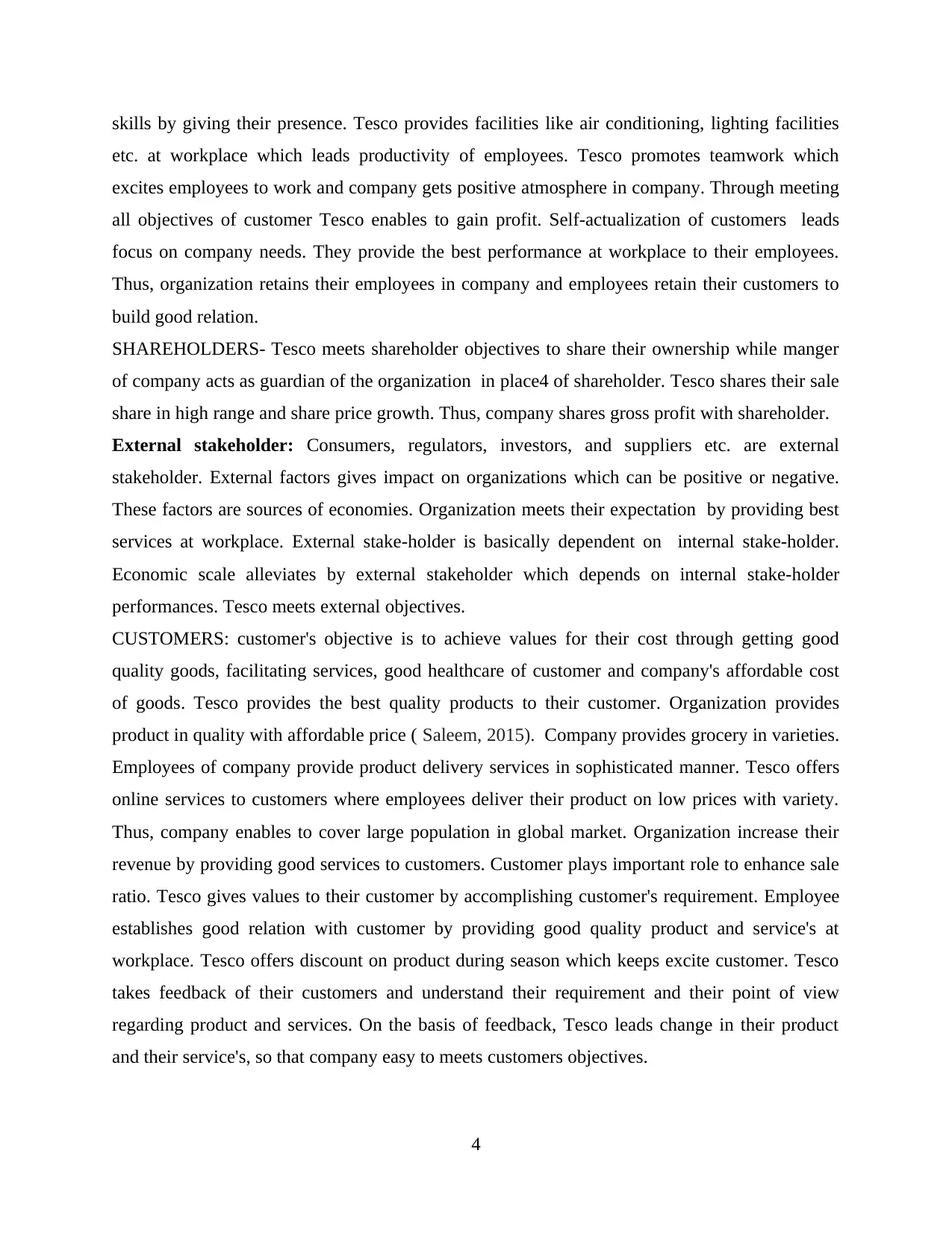
skills by giving their presence. Tesco provides facilities like air conditioning, lighting facilities
etc. at workplace which leads productivity of employees. Tesco promotes teamwork which
excites employees to work and company gets positive atmosphere in company. Through meeting
all objectives of customer Tesco enables to gain profit. Self-actualization of customers leads
focus on company needs. They provide the best performance at workplace to their employees.
Thus, organization retains their employees in company and employees retain their customers to
build good relation.
SHAREHOLDERS- Tesco meets shareholder objectives to share their ownership while manger
of company acts as guardian of the organization in place4 of shareholder. Tesco shares their sale
share in high range and share price growth. Thus, company shares gross profit with shareholder.
External stakeholder: Consumers, regulators, investors, and suppliers etc. are external
stakeholder. External factors gives impact on organizations which can be positive or negative.
These factors are sources of economies. Organization meets their expectation by providing best
services at workplace. External stake-holder is basically dependent on internal stake-holder.
Economic scale alleviates by external stakeholder which depends on internal stake-holder
performances. Tesco meets external objectives.
CUSTOMERS: customer's objective is to achieve values for their cost through getting good
quality goods, facilitating services, good healthcare of customer and company's affordable cost
of goods. Tesco provides the best quality products to their customer. Organization provides
product in quality with affordable price ( Saleem, 2015). Company provides grocery in varieties.
Employees of company provide product delivery services in sophisticated manner. Tesco offers
online services to customers where employees deliver their product on low prices with variety.
Thus, company enables to cover large population in global market. Organization increase their
revenue by providing good services to customers. Customer plays important role to enhance sale
ratio. Tesco gives values to their customer by accomplishing customer's requirement. Employee
establishes good relation with customer by providing good quality product and service's at
workplace. Tesco offers discount on product during season which keeps excite customer. Tesco
takes feedback of their customers and understand their requirement and their point of view
regarding product and services. On the basis of feedback, Tesco leads change in their product
and their service's, so that company easy to meets customers objectives.
4
etc. at workplace which leads productivity of employees. Tesco promotes teamwork which
excites employees to work and company gets positive atmosphere in company. Through meeting
all objectives of customer Tesco enables to gain profit. Self-actualization of customers leads
focus on company needs. They provide the best performance at workplace to their employees.
Thus, organization retains their employees in company and employees retain their customers to
build good relation.
SHAREHOLDERS- Tesco meets shareholder objectives to share their ownership while manger
of company acts as guardian of the organization in place4 of shareholder. Tesco shares their sale
share in high range and share price growth. Thus, company shares gross profit with shareholder.
External stakeholder: Consumers, regulators, investors, and suppliers etc. are external
stakeholder. External factors gives impact on organizations which can be positive or negative.
These factors are sources of economies. Organization meets their expectation by providing best
services at workplace. External stake-holder is basically dependent on internal stake-holder.
Economic scale alleviates by external stakeholder which depends on internal stake-holder
performances. Tesco meets external objectives.
CUSTOMERS: customer's objective is to achieve values for their cost through getting good
quality goods, facilitating services, good healthcare of customer and company's affordable cost
of goods. Tesco provides the best quality products to their customer. Organization provides
product in quality with affordable price ( Saleem, 2015). Company provides grocery in varieties.
Employees of company provide product delivery services in sophisticated manner. Tesco offers
online services to customers where employees deliver their product on low prices with variety.
Thus, company enables to cover large population in global market. Organization increase their
revenue by providing good services to customers. Customer plays important role to enhance sale
ratio. Tesco gives values to their customer by accomplishing customer's requirement. Employee
establishes good relation with customer by providing good quality product and service's at
workplace. Tesco offers discount on product during season which keeps excite customer. Tesco
takes feedback of their customers and understand their requirement and their point of view
regarding product and services. On the basis of feedback, Tesco leads change in their product
and their service's, so that company easy to meets customers objectives.
4
⊘ This is a preview!⊘
Do you want full access?
Subscribe today to unlock all pages.

Trusted by 1+ million students worldwide

GOVERNMENT: Government plays crucial role in business environment which gives positive
or negative impact on organization. In two cases government can impact company. For example
if company doesn't follow government policies then it can give impact on economy scale while
In second case if company meets government policies then supports to elevate economical scale
of company. Government objectives is to verify that all organizations stay on policies by the
current legal condition. Tesco keeps variation in governmental policies where company keeps
tax payment portfolio. Company also keeps licence of their business and keeps standardization in
product quality and gives assurity of customer's welfare protection. Such kind policies meet to
government policies. Through policies Tesco enables to enter in global market and raises
economical scale by selling standard quality goods to customers.
CREDITORS & BONDHOLDER: Creditor of banks provides finance supports to company by
issuing loans at low interest and purchasing business firm bonds. Main goal of creditor is to
receive payment of loan timely and earns good interest from loan. They also need assurity about
money that will secure. Tesco gives assurity of their money and meets their objectives by
providing loan payment on time. Thus, organization meets creditors objectives.
Through external and internal stake-holder company eligibles to achieve organization goals by
fulfilling their objectives. Thus, Tesco focuses on their objectives.
LO3
C) Pestle analysis method
Pestle analysis is basically designed to analyses impact on business environment where
analyses activities of business environment. Pestle contains four factors political, economical,
social, technological and legal factors.
Political factor: Political factors are political stability and political instability, corruption,
competition regulation, tax policy, foreign tax policy, consumer & labour protection law etc.
which gives negative and positive impact on business environment of Tesco. Tesco is a grocery
retailing company and headquarter in UK.
Positive Impacts: Tesco gets positive impact from political factor. For example government
stability in UK. Through stability of government policies, Tesco enables to retail their goods on
large scale. Government also supports retailer to create opportunity for job where organization
plays vital role to creates recruitment for employees. Such kind supports leads profitability in
5
or negative impact on organization. In two cases government can impact company. For example
if company doesn't follow government policies then it can give impact on economy scale while
In second case if company meets government policies then supports to elevate economical scale
of company. Government objectives is to verify that all organizations stay on policies by the
current legal condition. Tesco keeps variation in governmental policies where company keeps
tax payment portfolio. Company also keeps licence of their business and keeps standardization in
product quality and gives assurity of customer's welfare protection. Such kind policies meet to
government policies. Through policies Tesco enables to enter in global market and raises
economical scale by selling standard quality goods to customers.
CREDITORS & BONDHOLDER: Creditor of banks provides finance supports to company by
issuing loans at low interest and purchasing business firm bonds. Main goal of creditor is to
receive payment of loan timely and earns good interest from loan. They also need assurity about
money that will secure. Tesco gives assurity of their money and meets their objectives by
providing loan payment on time. Thus, organization meets creditors objectives.
Through external and internal stake-holder company eligibles to achieve organization goals by
fulfilling their objectives. Thus, Tesco focuses on their objectives.
LO3
C) Pestle analysis method
Pestle analysis is basically designed to analyses impact on business environment where
analyses activities of business environment. Pestle contains four factors political, economical,
social, technological and legal factors.
Political factor: Political factors are political stability and political instability, corruption,
competition regulation, tax policy, foreign tax policy, consumer & labour protection law etc.
which gives negative and positive impact on business environment of Tesco. Tesco is a grocery
retailing company and headquarter in UK.
Positive Impacts: Tesco gets positive impact from political factor. For example government
stability in UK. Through stability of government policies, Tesco enables to retail their goods on
large scale. Government also supports retailer to create opportunity for job where organization
plays vital role to creates recruitment for employees. Such kind supports leads profitability in
5
Paraphrase This Document
Need a fresh take? Get an instant paraphrase of this document with our AI Paraphraser
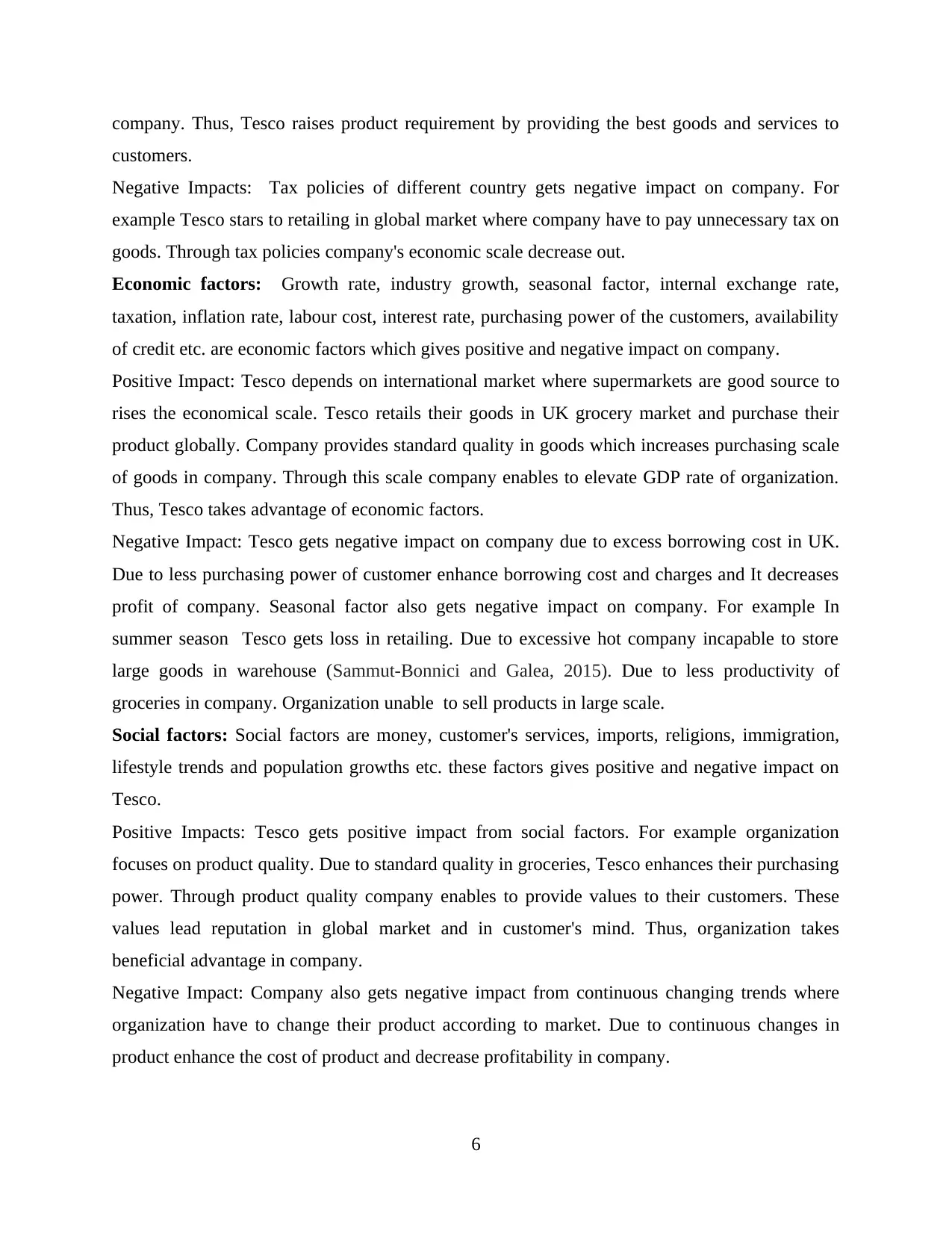
company. Thus, Tesco raises product requirement by providing the best goods and services to
customers.
Negative Impacts: Tax policies of different country gets negative impact on company. For
example Tesco stars to retailing in global market where company have to pay unnecessary tax on
goods. Through tax policies company's economic scale decrease out.
Economic factors: Growth rate, industry growth, seasonal factor, internal exchange rate,
taxation, inflation rate, labour cost, interest rate, purchasing power of the customers, availability
of credit etc. are economic factors which gives positive and negative impact on company.
Positive Impact: Tesco depends on international market where supermarkets are good source to
rises the economical scale. Tesco retails their goods in UK grocery market and purchase their
product globally. Company provides standard quality in goods which increases purchasing scale
of goods in company. Through this scale company enables to elevate GDP rate of organization.
Thus, Tesco takes advantage of economic factors.
Negative Impact: Tesco gets negative impact on company due to excess borrowing cost in UK.
Due to less purchasing power of customer enhance borrowing cost and charges and It decreases
profit of company. Seasonal factor also gets negative impact on company. For example In
summer season Tesco gets loss in retailing. Due to excessive hot company incapable to store
large goods in warehouse (Sammut‐Bonnici and Galea, 2015). Due to less productivity of
groceries in company. Organization unable to sell products in large scale.
Social factors: Social factors are money, customer's services, imports, religions, immigration,
lifestyle trends and population growths etc. these factors gives positive and negative impact on
Tesco.
Positive Impacts: Tesco gets positive impact from social factors. For example organization
focuses on product quality. Due to standard quality in groceries, Tesco enhances their purchasing
power. Through product quality company enables to provide values to their customers. These
values lead reputation in global market and in customer's mind. Thus, organization takes
beneficial advantage in company.
Negative Impact: Company also gets negative impact from continuous changing trends where
organization have to change their product according to market. Due to continuous changes in
product enhance the cost of product and decrease profitability in company.
6
customers.
Negative Impacts: Tax policies of different country gets negative impact on company. For
example Tesco stars to retailing in global market where company have to pay unnecessary tax on
goods. Through tax policies company's economic scale decrease out.
Economic factors: Growth rate, industry growth, seasonal factor, internal exchange rate,
taxation, inflation rate, labour cost, interest rate, purchasing power of the customers, availability
of credit etc. are economic factors which gives positive and negative impact on company.
Positive Impact: Tesco depends on international market where supermarkets are good source to
rises the economical scale. Tesco retails their goods in UK grocery market and purchase their
product globally. Company provides standard quality in goods which increases purchasing scale
of goods in company. Through this scale company enables to elevate GDP rate of organization.
Thus, Tesco takes advantage of economic factors.
Negative Impact: Tesco gets negative impact on company due to excess borrowing cost in UK.
Due to less purchasing power of customer enhance borrowing cost and charges and It decreases
profit of company. Seasonal factor also gets negative impact on company. For example In
summer season Tesco gets loss in retailing. Due to excessive hot company incapable to store
large goods in warehouse (Sammut‐Bonnici and Galea, 2015). Due to less productivity of
groceries in company. Organization unable to sell products in large scale.
Social factors: Social factors are money, customer's services, imports, religions, immigration,
lifestyle trends and population growths etc. these factors gives positive and negative impact on
Tesco.
Positive Impacts: Tesco gets positive impact from social factors. For example organization
focuses on product quality. Due to standard quality in groceries, Tesco enhances their purchasing
power. Through product quality company enables to provide values to their customers. These
values lead reputation in global market and in customer's mind. Thus, organization takes
beneficial advantage in company.
Negative Impact: Company also gets negative impact from continuous changing trends where
organization have to change their product according to market. Due to continuous changes in
product enhance the cost of product and decrease profitability in company.
6

Technological factors: research and innovation, consumer access technology and emerging
technology are technological factors which impact Tesco environments.
Positive Impact: Technology provides various opportunity for company. It gives positive impact
on purchasing scale. For example online shopping, It is new technology where Tesco takes
advantages to delivering their good in large scale in global market. Organization also provide
own online shopping apps to customers where they can purchase product on affordable prices
rather to come in store. It leads easiness for customer's and company enables to increase
economical scale. Thus, Tesco gets profitability by purchasing scales.
Negative Impact: Due to continuous changes in technology, It enhances cost of technology
which impacts on company economy. Cause of unawareness of new technology, Tesco
sometimes unable to promote their purchasing their goods which create threats for company.
Legal factors: consumer law, fraud law, employment law, health and safety law and import-
export law are legal factors which impact business environment of Tesco.
Positive impact: Tesco get positive aspect from legal factors. For example health safety law,
company focuses on product quality and delivers their product on standard quality it enhances
purchasing scale of company (Taghian, D’Souza. and Polonsky, 2015.). Through product
quality, organization gets values from customer and government. Thus, organization enhances
product demand in market.
Negative Impact: Tesco is a UK company where country keeps their rules for importing and
exporting product. For example UK allows exporting product in limited countries. In that state
organization gets negative impact on company's economy because Tesco can't export their goods
in various country. It gives negative impact on GDP rate of company.
Environmental factors: packaging and pollution etc. are environmental factors which impacts
organization economy. Environmental factor gives negative and positive impact on business
economy.
Positive Impact: Tesco gives good packaging services to their customers. It enhances customer's
satisfaction regarding their product services.
Negative Impacts: Due to pollution and adulteration of chemical during farming reduces' product
quality which causes Tesco have to pay more attention and have to pay high cost which can give
negative impact on company economy.
7
technology are technological factors which impact Tesco environments.
Positive Impact: Technology provides various opportunity for company. It gives positive impact
on purchasing scale. For example online shopping, It is new technology where Tesco takes
advantages to delivering their good in large scale in global market. Organization also provide
own online shopping apps to customers where they can purchase product on affordable prices
rather to come in store. It leads easiness for customer's and company enables to increase
economical scale. Thus, Tesco gets profitability by purchasing scales.
Negative Impact: Due to continuous changes in technology, It enhances cost of technology
which impacts on company economy. Cause of unawareness of new technology, Tesco
sometimes unable to promote their purchasing their goods which create threats for company.
Legal factors: consumer law, fraud law, employment law, health and safety law and import-
export law are legal factors which impact business environment of Tesco.
Positive impact: Tesco get positive aspect from legal factors. For example health safety law,
company focuses on product quality and delivers their product on standard quality it enhances
purchasing scale of company (Taghian, D’Souza. and Polonsky, 2015.). Through product
quality, organization gets values from customer and government. Thus, organization enhances
product demand in market.
Negative Impact: Tesco is a UK company where country keeps their rules for importing and
exporting product. For example UK allows exporting product in limited countries. In that state
organization gets negative impact on company's economy because Tesco can't export their goods
in various country. It gives negative impact on GDP rate of company.
Environmental factors: packaging and pollution etc. are environmental factors which impacts
organization economy. Environmental factor gives negative and positive impact on business
economy.
Positive Impact: Tesco gives good packaging services to their customers. It enhances customer's
satisfaction regarding their product services.
Negative Impacts: Due to pollution and adulteration of chemical during farming reduces' product
quality which causes Tesco have to pay more attention and have to pay high cost which can give
negative impact on company economy.
7
⊘ This is a preview!⊘
Do you want full access?
Subscribe today to unlock all pages.

Trusted by 1+ million students worldwide
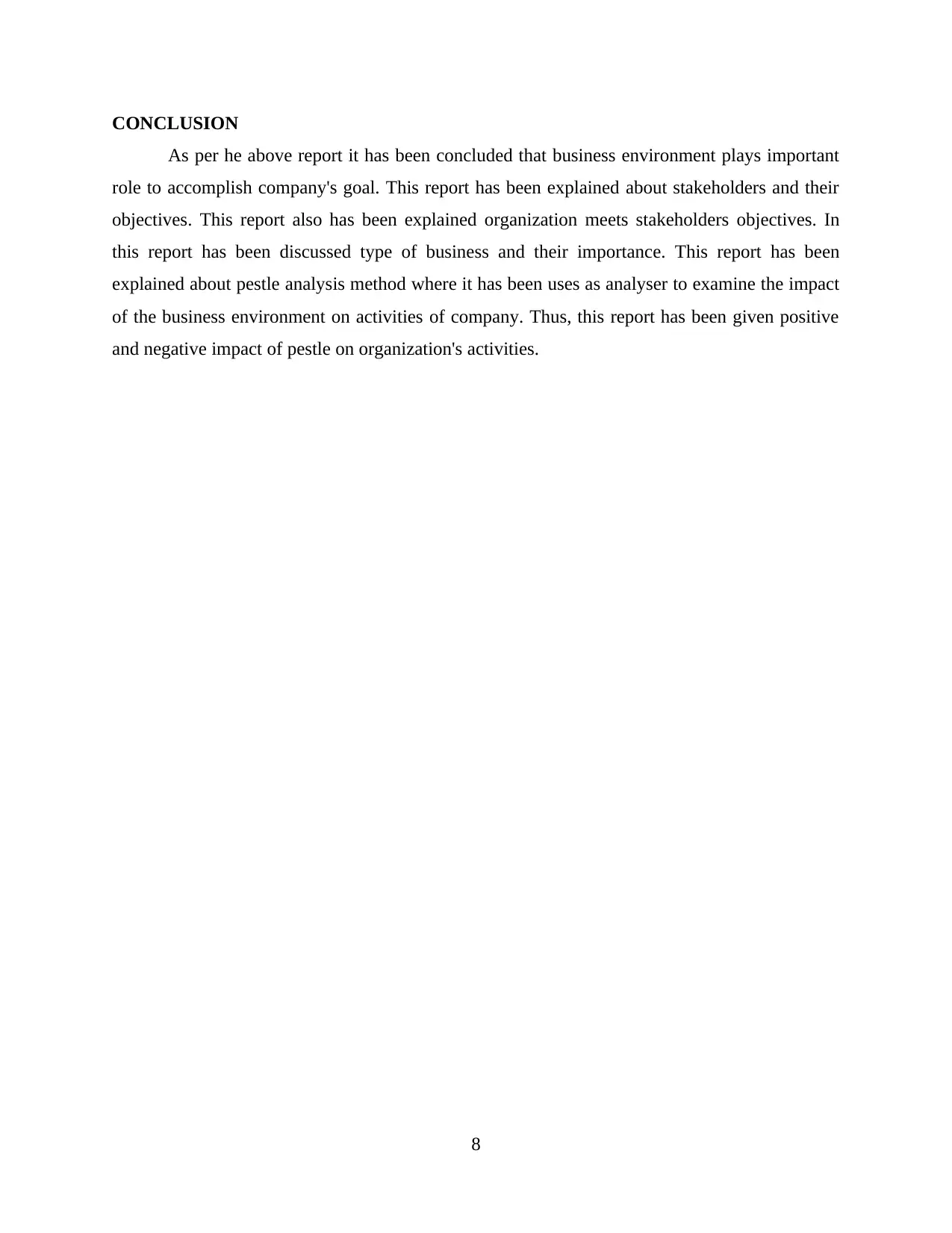
CONCLUSION
As per he above report it has been concluded that business environment plays important
role to accomplish company's goal. This report has been explained about stakeholders and their
objectives. This report also has been explained organization meets stakeholders objectives. In
this report has been discussed type of business and their importance. This report has been
explained about pestle analysis method where it has been uses as analyser to examine the impact
of the business environment on activities of company. Thus, this report has been given positive
and negative impact of pestle on organization's activities.
8
As per he above report it has been concluded that business environment plays important
role to accomplish company's goal. This report has been explained about stakeholders and their
objectives. This report also has been explained organization meets stakeholders objectives. In
this report has been discussed type of business and their importance. This report has been
explained about pestle analysis method where it has been uses as analyser to examine the impact
of the business environment on activities of company. Thus, this report has been given positive
and negative impact of pestle on organization's activities.
8
Paraphrase This Document
Need a fresh take? Get an instant paraphrase of this document with our AI Paraphraser
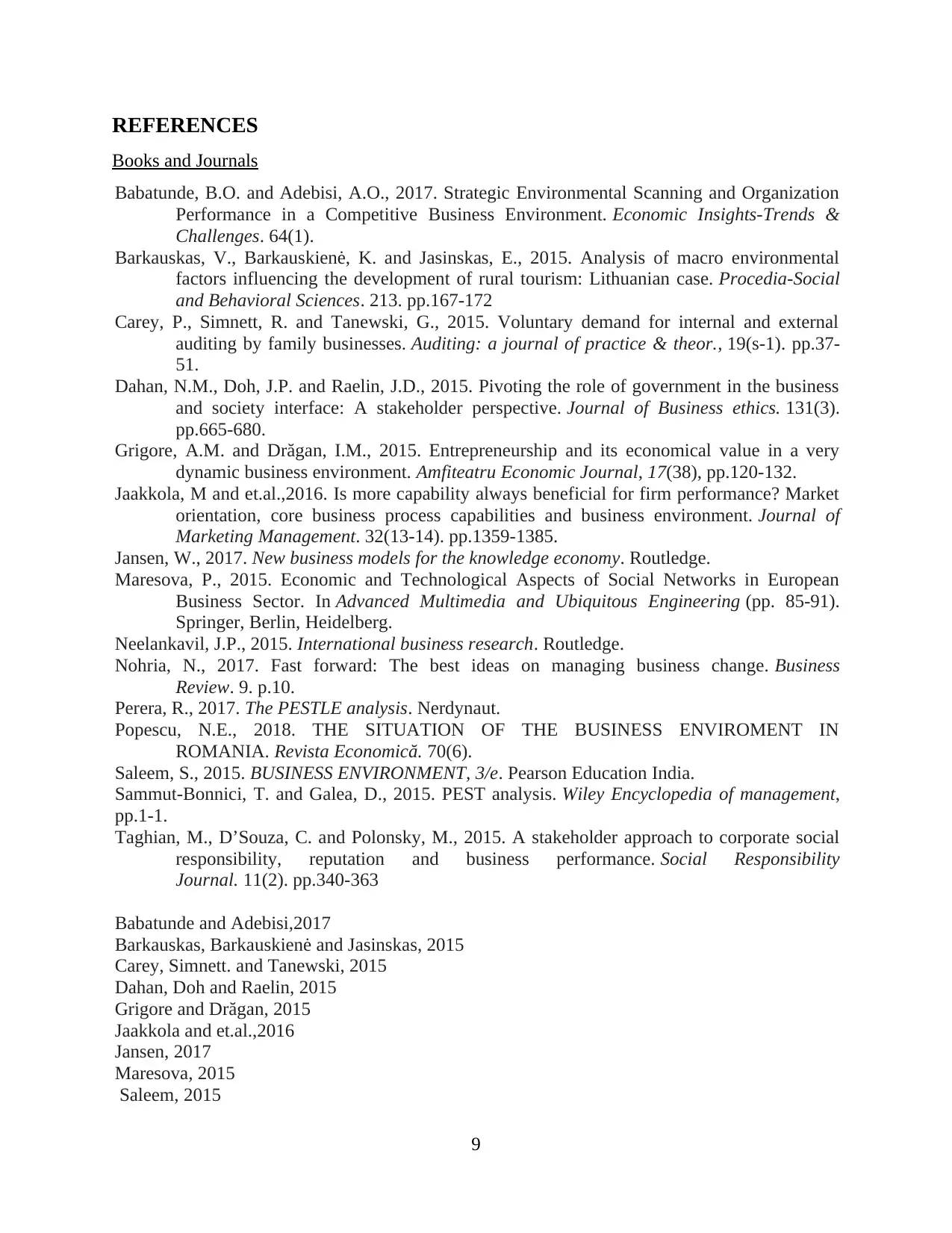
REFERENCES
Books and Journals
Babatunde, B.O. and Adebisi, A.O., 2017. Strategic Environmental Scanning and Organization
Performance in a Competitive Business Environment. Economic Insights-Trends &
Challenges. 64(1).
Barkauskas, V., Barkauskienė, K. and Jasinskas, E., 2015. Analysis of macro environmental
factors influencing the development of rural tourism: Lithuanian case. Procedia-Social
and Behavioral Sciences. 213. pp.167-172
Carey, P., Simnett, R. and Tanewski, G., 2015. Voluntary demand for internal and external
auditing by family businesses. Auditing: a journal of practice & theor., 19(s-1). pp.37-
51.
Dahan, N.M., Doh, J.P. and Raelin, J.D., 2015. Pivoting the role of government in the business
and society interface: A stakeholder perspective. Journal of Business ethics. 131(3).
pp.665-680.
Grigore, A.M. and Drăgan, I.M., 2015. Entrepreneurship and its economical value in a very
dynamic business environment. Amfiteatru Economic Journal, 17(38), pp.120-132.
Jaakkola, M and et.al.,2016. Is more capability always beneficial for firm performance? Market
orientation, core business process capabilities and business environment. Journal of
Marketing Management. 32(13-14). pp.1359-1385.
Jansen, W., 2017. New business models for the knowledge economy. Routledge.
Maresova, P., 2015. Economic and Technological Aspects of Social Networks in European
Business Sector. In Advanced Multimedia and Ubiquitous Engineering (pp. 85-91).
Springer, Berlin, Heidelberg.
Neelankavil, J.P., 2015. International business research. Routledge.
Nohria, N., 2017. Fast forward: The best ideas on managing business change. Business
Review. 9. p.10.
Perera, R., 2017. The PESTLE analysis. Nerdynaut.
Popescu, N.E., 2018. THE SITUATION OF THE BUSINESS ENVIROMENT IN
ROMANIA. Revista Economică. 70(6).
Saleem, S., 2015. BUSINESS ENVIRONMENT, 3/e. Pearson Education India.
Sammut‐Bonnici, T. and Galea, D., 2015. PEST analysis. Wiley Encyclopedia of management,
pp.1-1.
Taghian, M., D’Souza, C. and Polonsky, M., 2015. A stakeholder approach to corporate social
responsibility, reputation and business performance. Social Responsibility
Journal. 11(2). pp.340-363
Babatunde and Adebisi,2017
Barkauskas, Barkauskienė and Jasinskas, 2015
Carey, Simnett. and Tanewski, 2015
Dahan, Doh and Raelin, 2015
Grigore and Drăgan, 2015
Jaakkola and et.al.,2016
Jansen, 2017
Maresova, 2015
Saleem, 2015
9
Books and Journals
Babatunde, B.O. and Adebisi, A.O., 2017. Strategic Environmental Scanning and Organization
Performance in a Competitive Business Environment. Economic Insights-Trends &
Challenges. 64(1).
Barkauskas, V., Barkauskienė, K. and Jasinskas, E., 2015. Analysis of macro environmental
factors influencing the development of rural tourism: Lithuanian case. Procedia-Social
and Behavioral Sciences. 213. pp.167-172
Carey, P., Simnett, R. and Tanewski, G., 2015. Voluntary demand for internal and external
auditing by family businesses. Auditing: a journal of practice & theor., 19(s-1). pp.37-
51.
Dahan, N.M., Doh, J.P. and Raelin, J.D., 2015. Pivoting the role of government in the business
and society interface: A stakeholder perspective. Journal of Business ethics. 131(3).
pp.665-680.
Grigore, A.M. and Drăgan, I.M., 2015. Entrepreneurship and its economical value in a very
dynamic business environment. Amfiteatru Economic Journal, 17(38), pp.120-132.
Jaakkola, M and et.al.,2016. Is more capability always beneficial for firm performance? Market
orientation, core business process capabilities and business environment. Journal of
Marketing Management. 32(13-14). pp.1359-1385.
Jansen, W., 2017. New business models for the knowledge economy. Routledge.
Maresova, P., 2015. Economic and Technological Aspects of Social Networks in European
Business Sector. In Advanced Multimedia and Ubiquitous Engineering (pp. 85-91).
Springer, Berlin, Heidelberg.
Neelankavil, J.P., 2015. International business research. Routledge.
Nohria, N., 2017. Fast forward: The best ideas on managing business change. Business
Review. 9. p.10.
Perera, R., 2017. The PESTLE analysis. Nerdynaut.
Popescu, N.E., 2018. THE SITUATION OF THE BUSINESS ENVIROMENT IN
ROMANIA. Revista Economică. 70(6).
Saleem, S., 2015. BUSINESS ENVIRONMENT, 3/e. Pearson Education India.
Sammut‐Bonnici, T. and Galea, D., 2015. PEST analysis. Wiley Encyclopedia of management,
pp.1-1.
Taghian, M., D’Souza, C. and Polonsky, M., 2015. A stakeholder approach to corporate social
responsibility, reputation and business performance. Social Responsibility
Journal. 11(2). pp.340-363
Babatunde and Adebisi,2017
Barkauskas, Barkauskienė and Jasinskas, 2015
Carey, Simnett. and Tanewski, 2015
Dahan, Doh and Raelin, 2015
Grigore and Drăgan, 2015
Jaakkola and et.al.,2016
Jansen, 2017
Maresova, 2015
Saleem, 2015
9
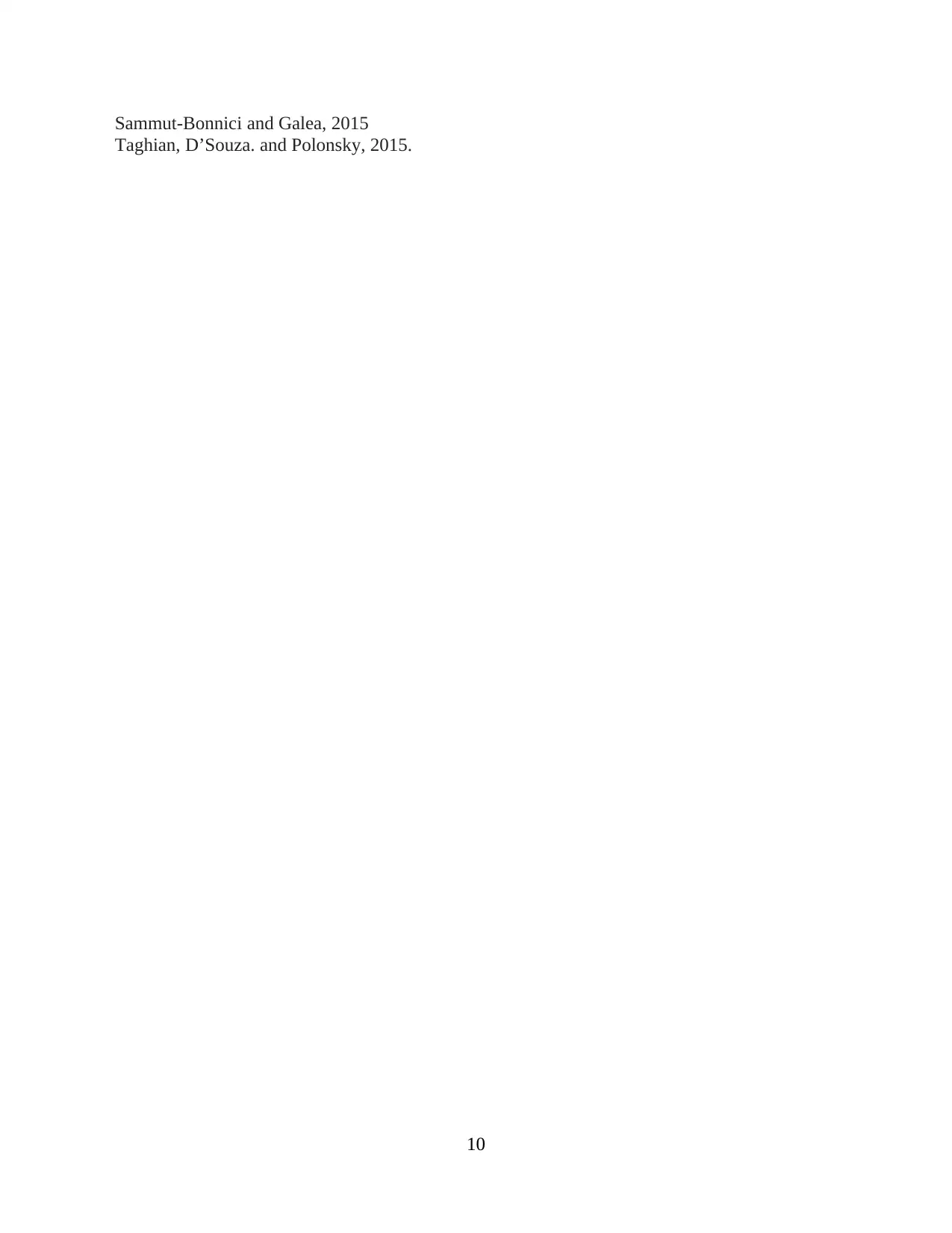
Sammut‐Bonnici and Galea, 2015
Taghian, D’Souza. and Polonsky, 2015.
10
Taghian, D’Souza. and Polonsky, 2015.
10
⊘ This is a preview!⊘
Do you want full access?
Subscribe today to unlock all pages.

Trusted by 1+ million students worldwide
1 out of 12
Related Documents
Your All-in-One AI-Powered Toolkit for Academic Success.
+13062052269
info@desklib.com
Available 24*7 on WhatsApp / Email
![[object Object]](/_next/static/media/star-bottom.7253800d.svg)
Unlock your academic potential
Copyright © 2020–2025 A2Z Services. All Rights Reserved. Developed and managed by ZUCOL.





